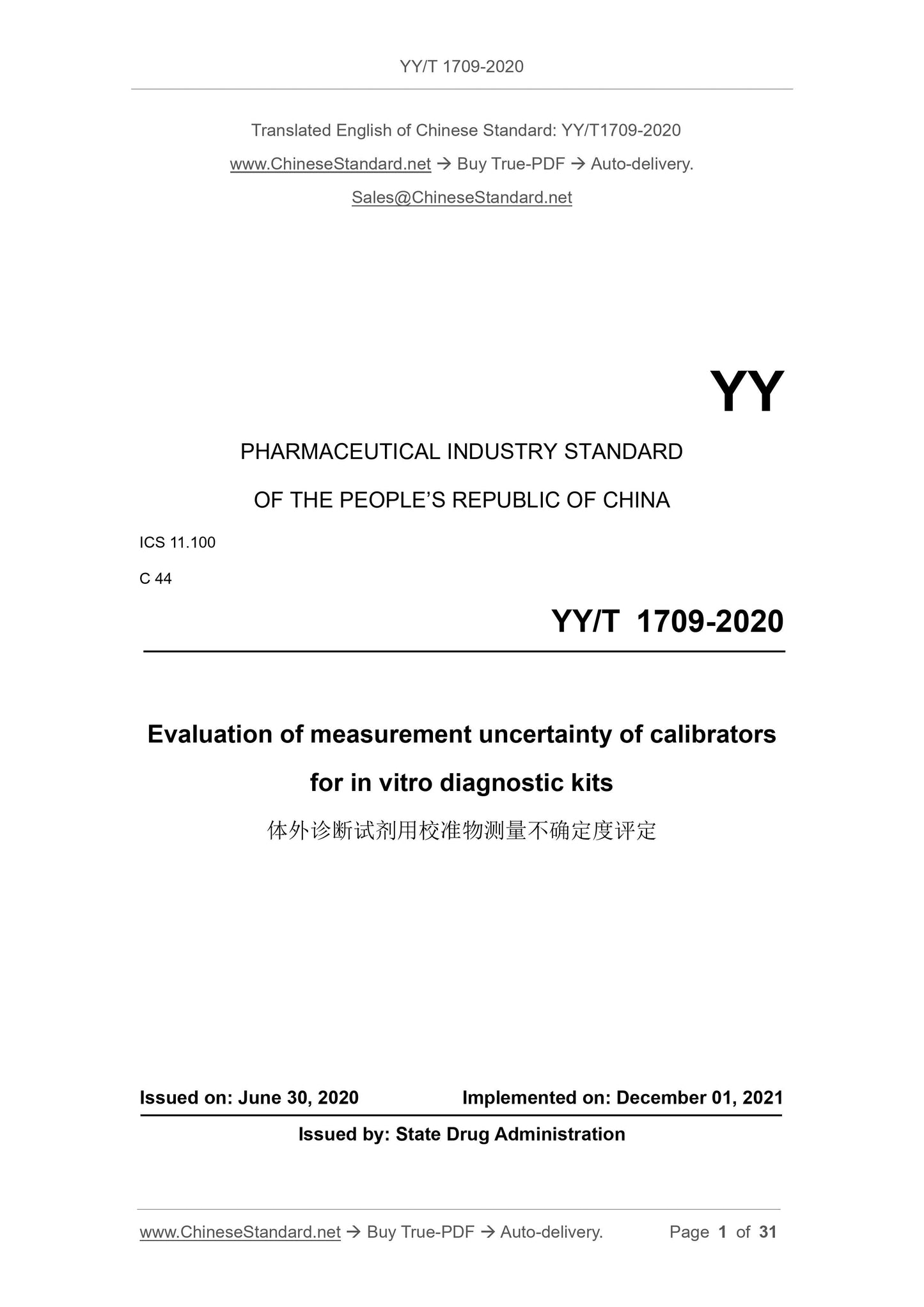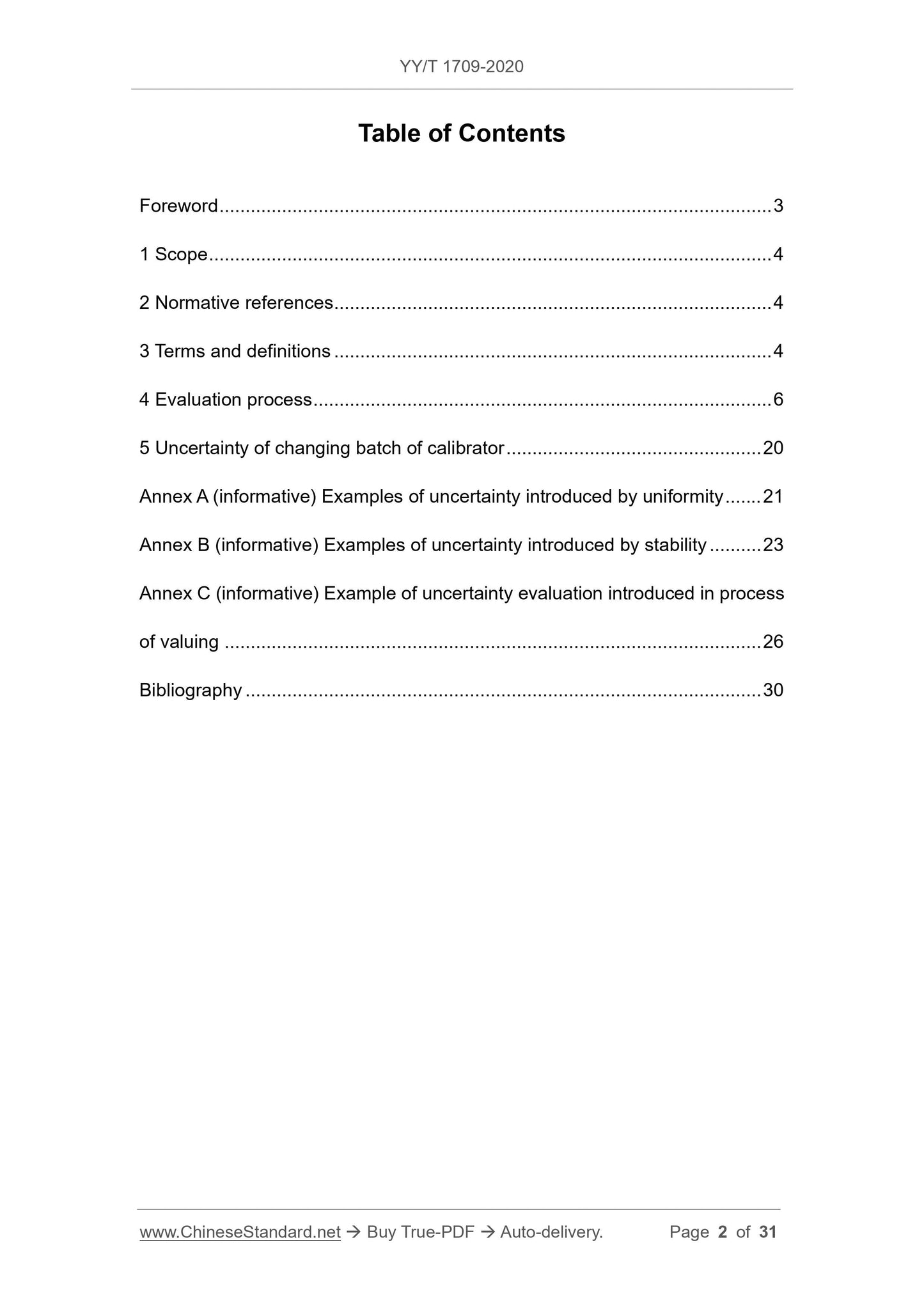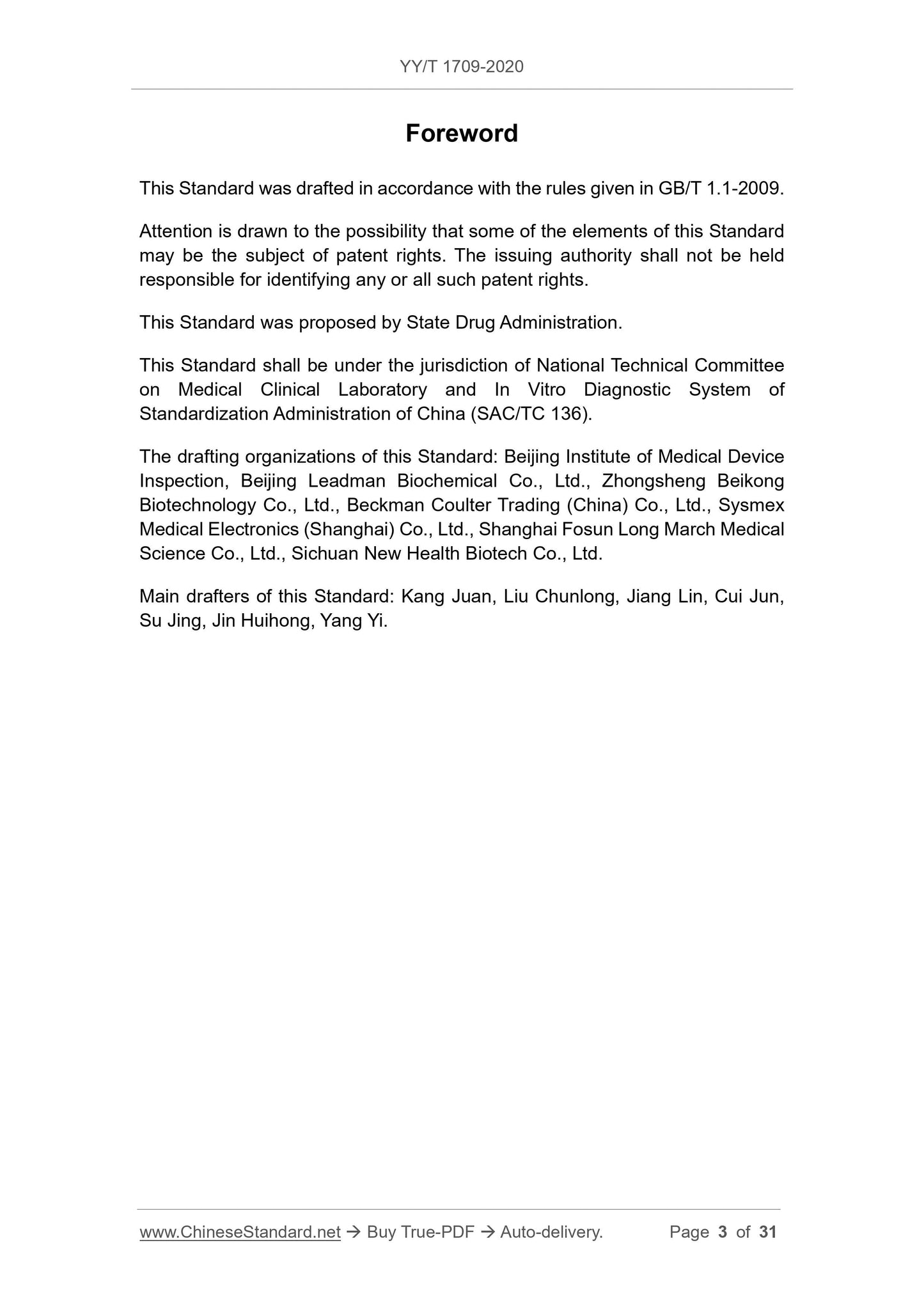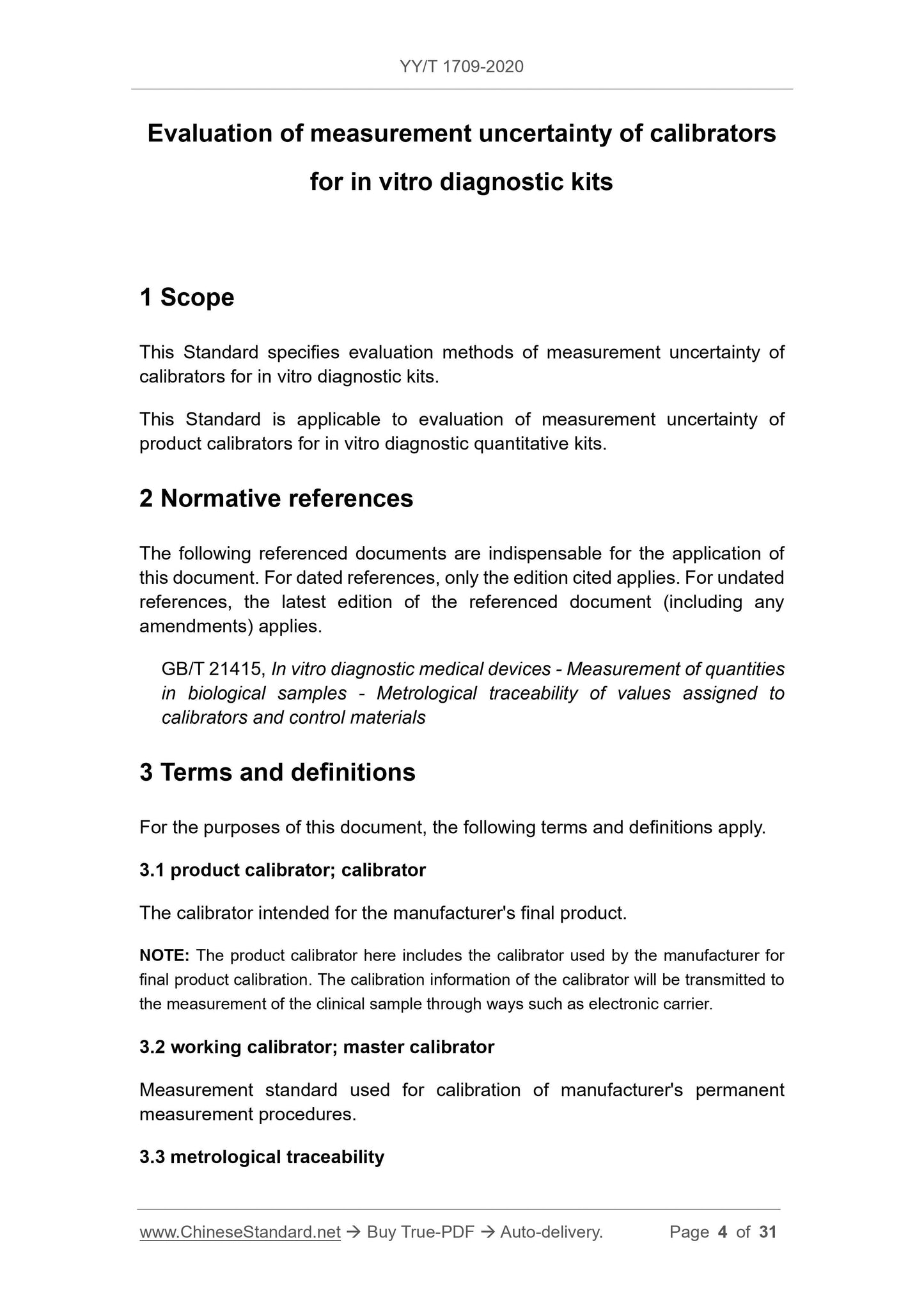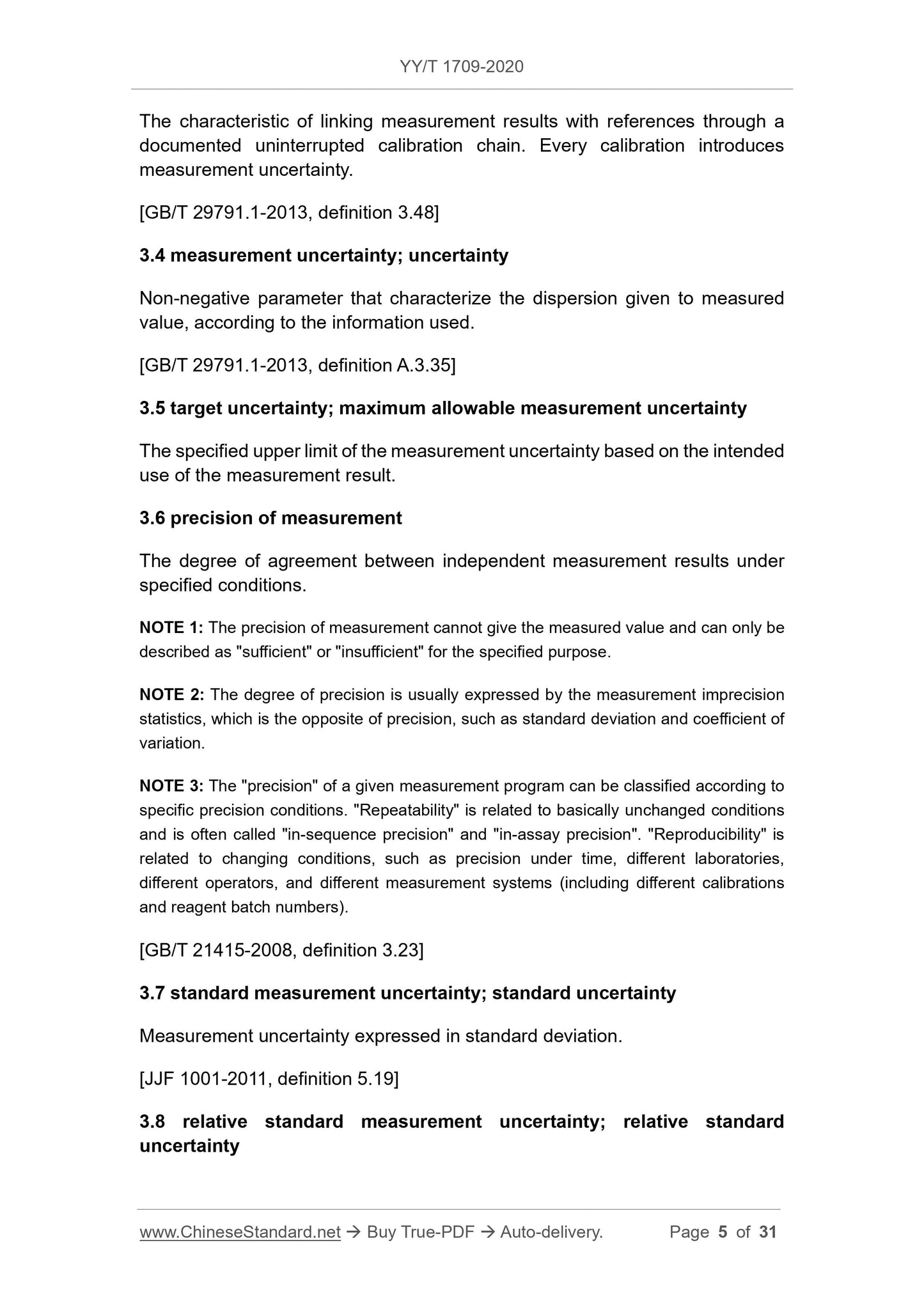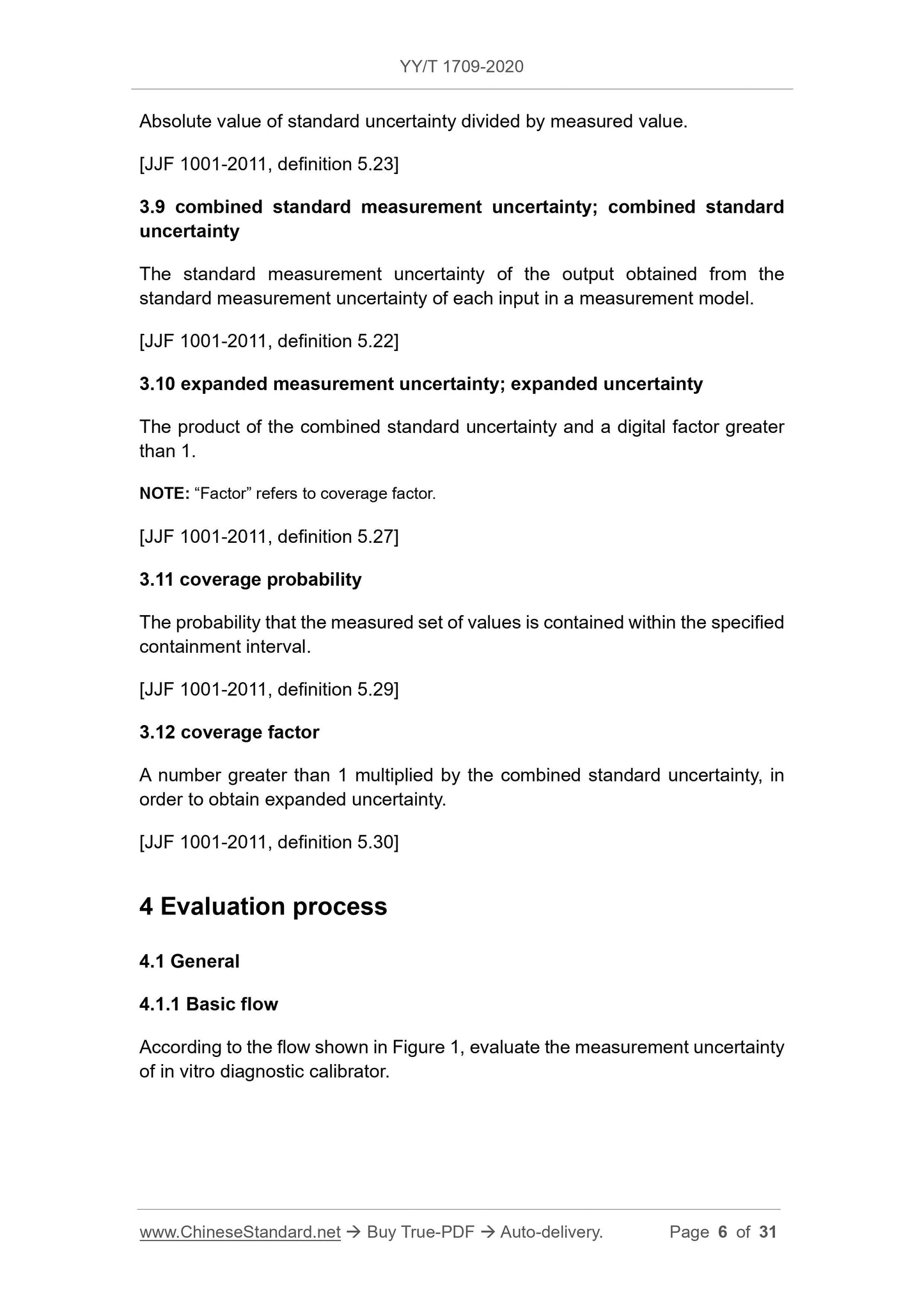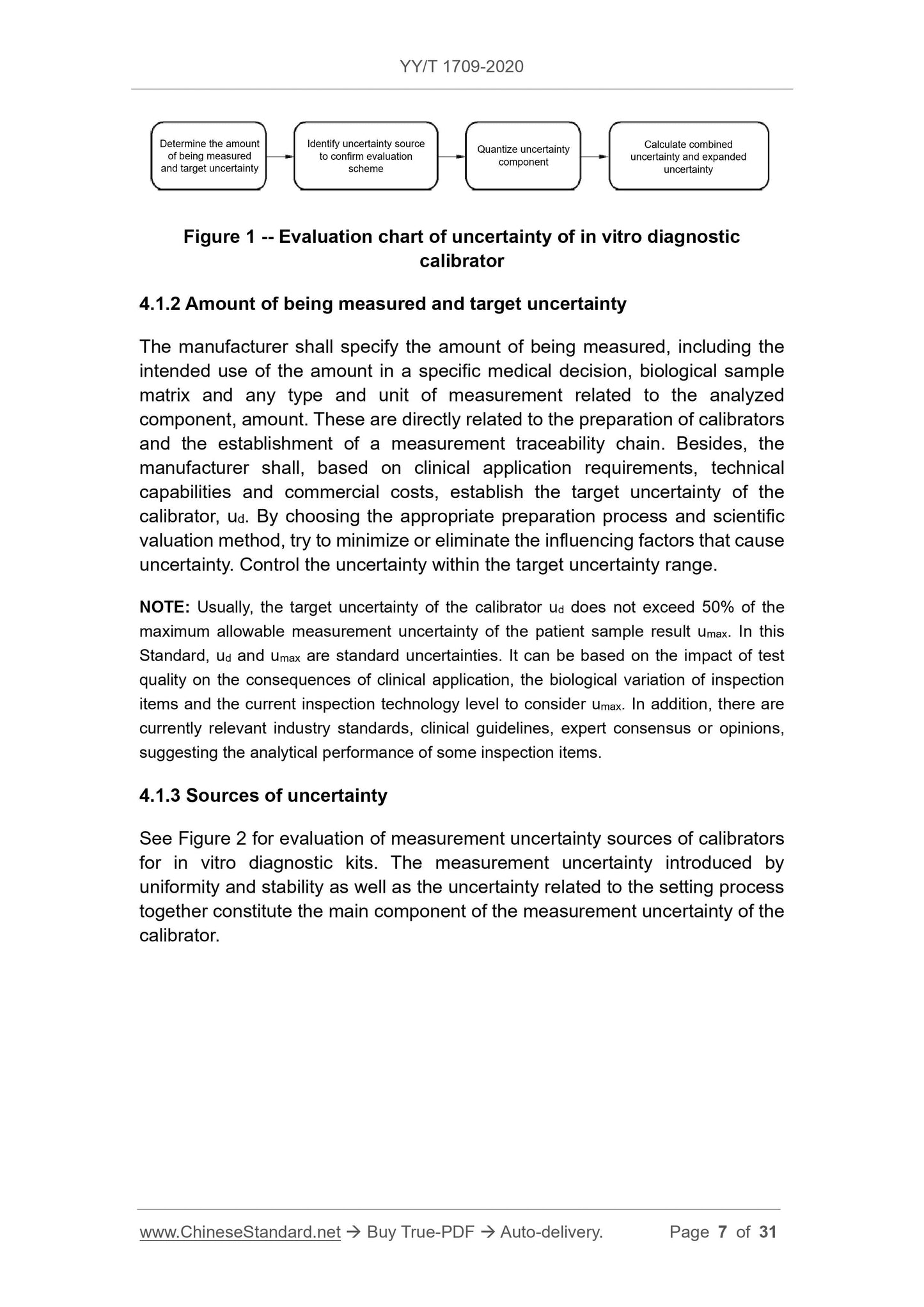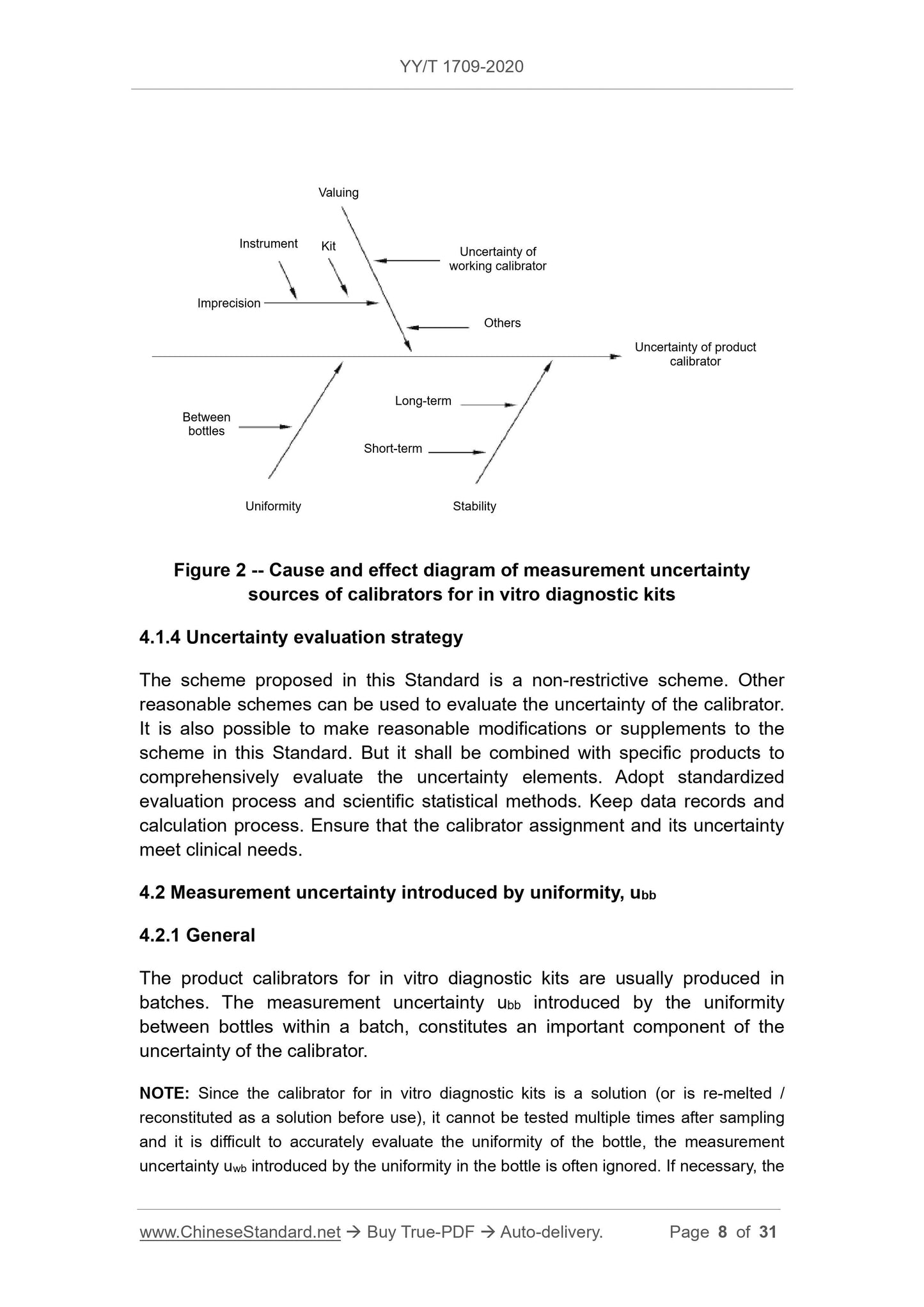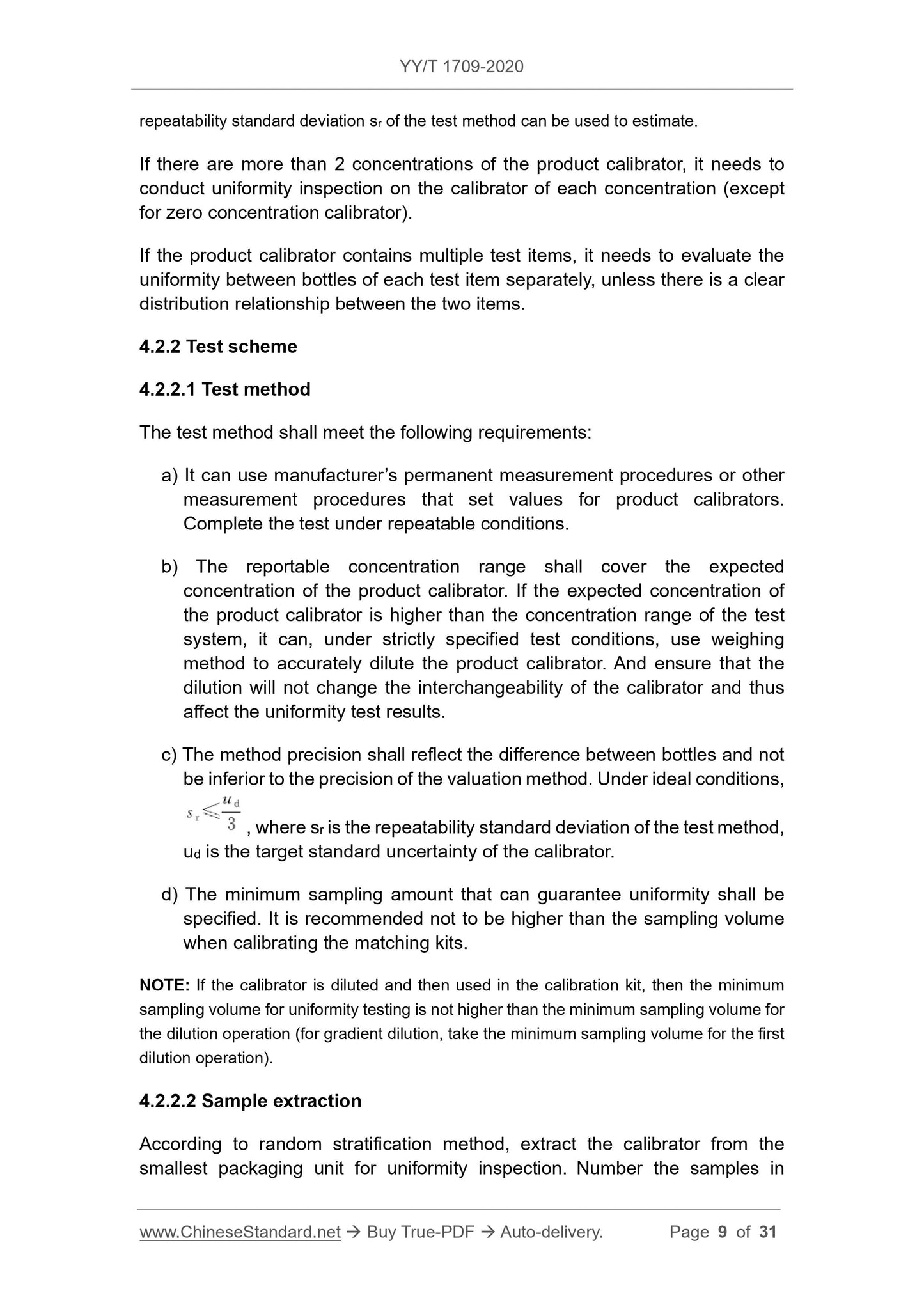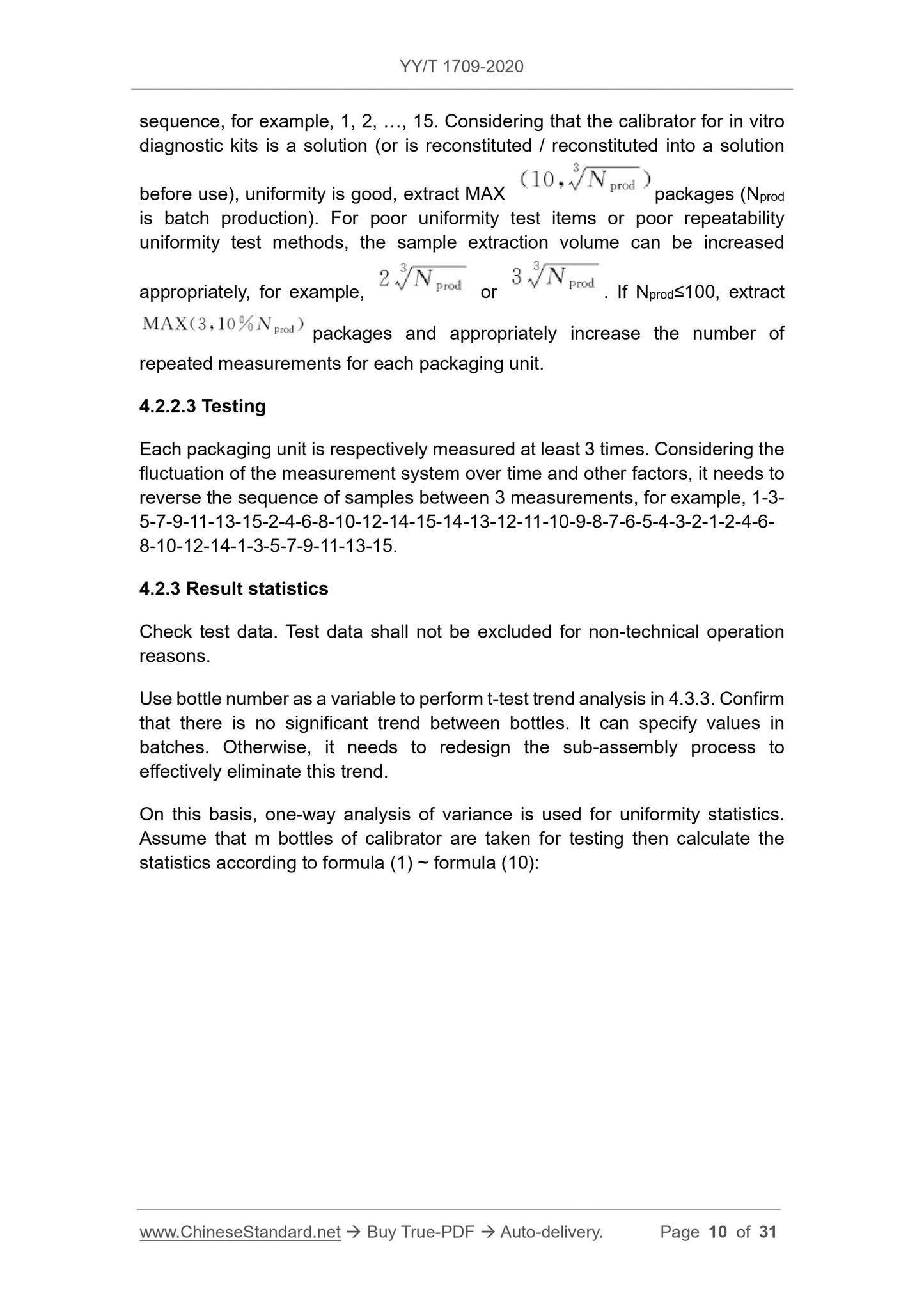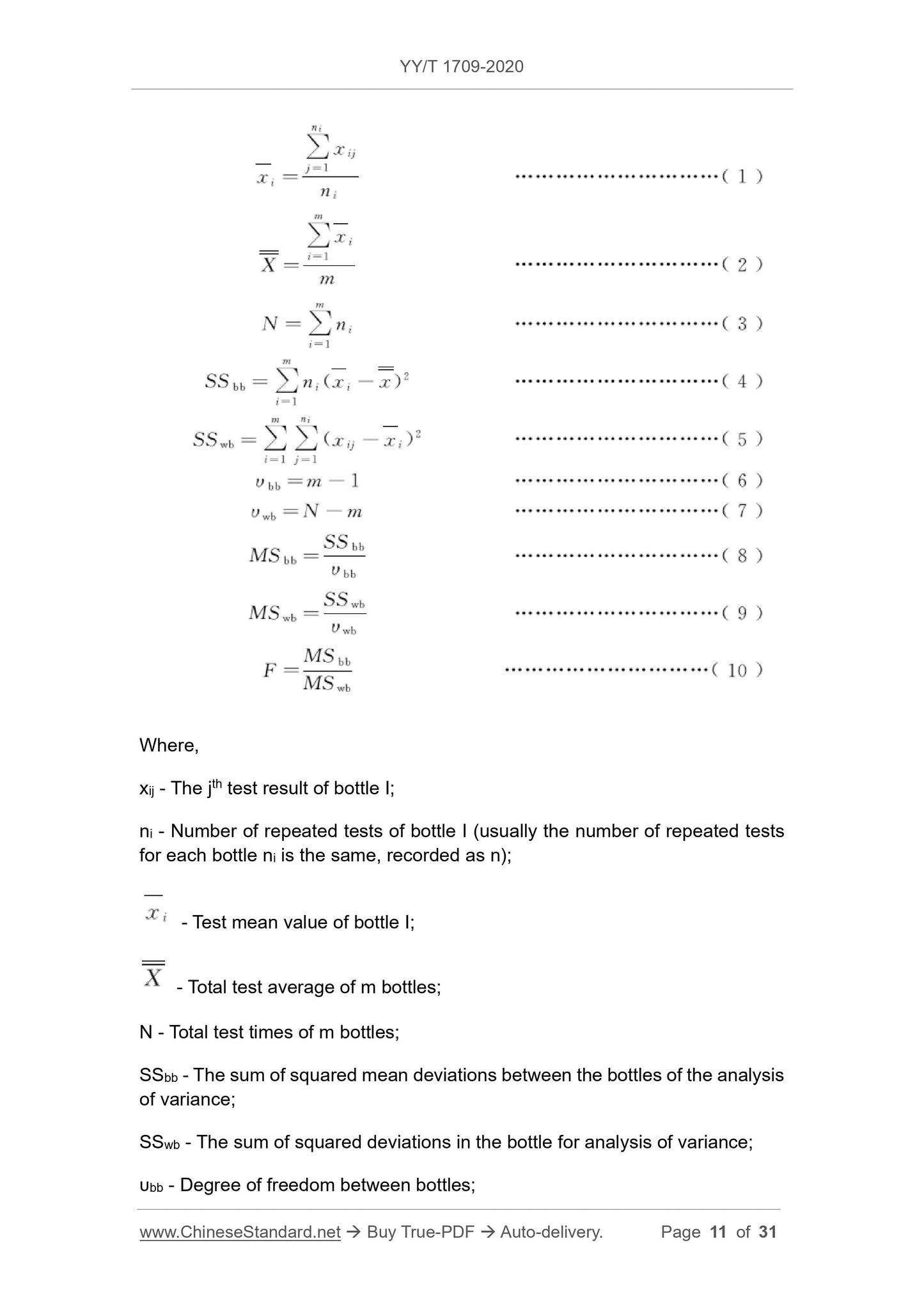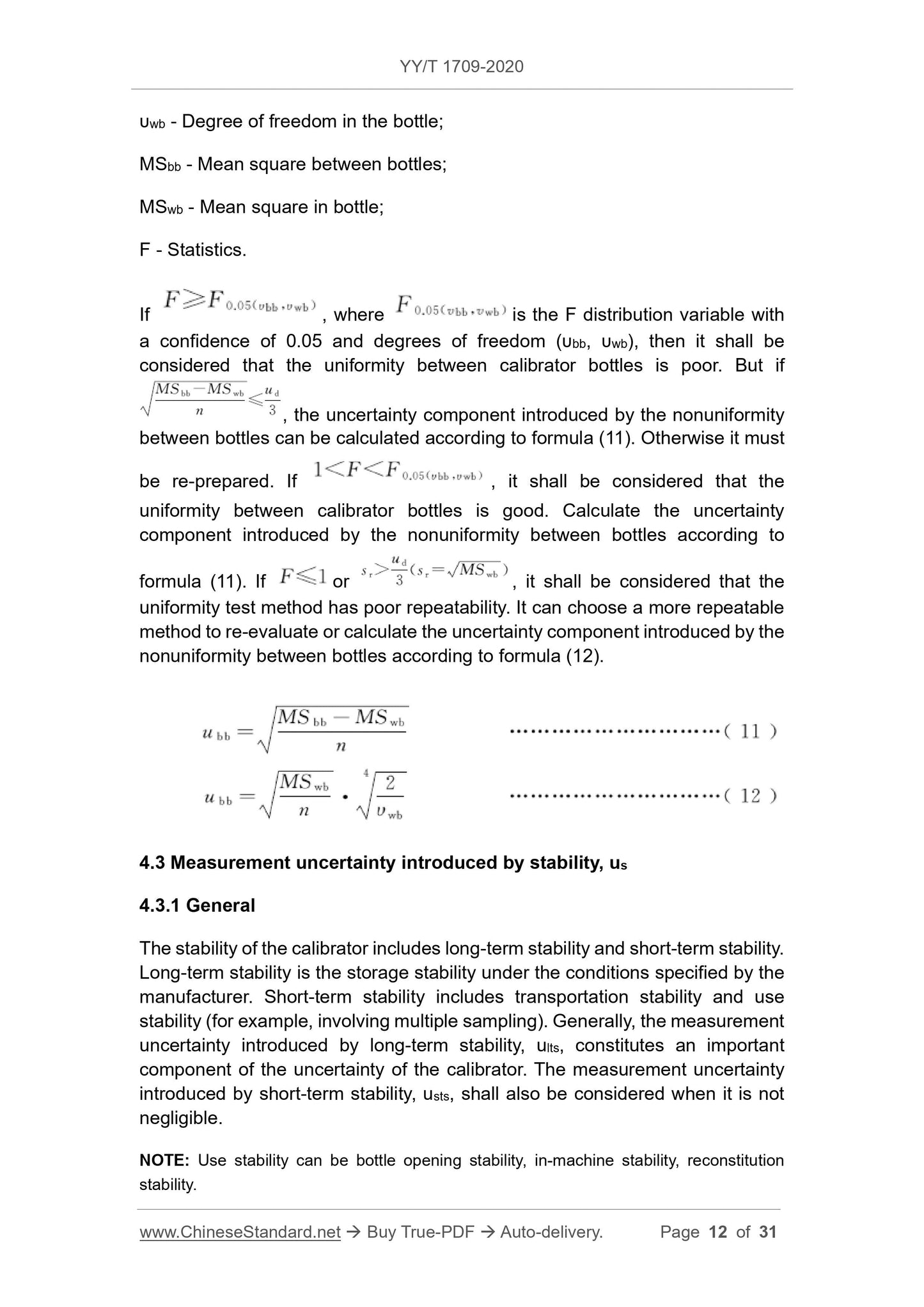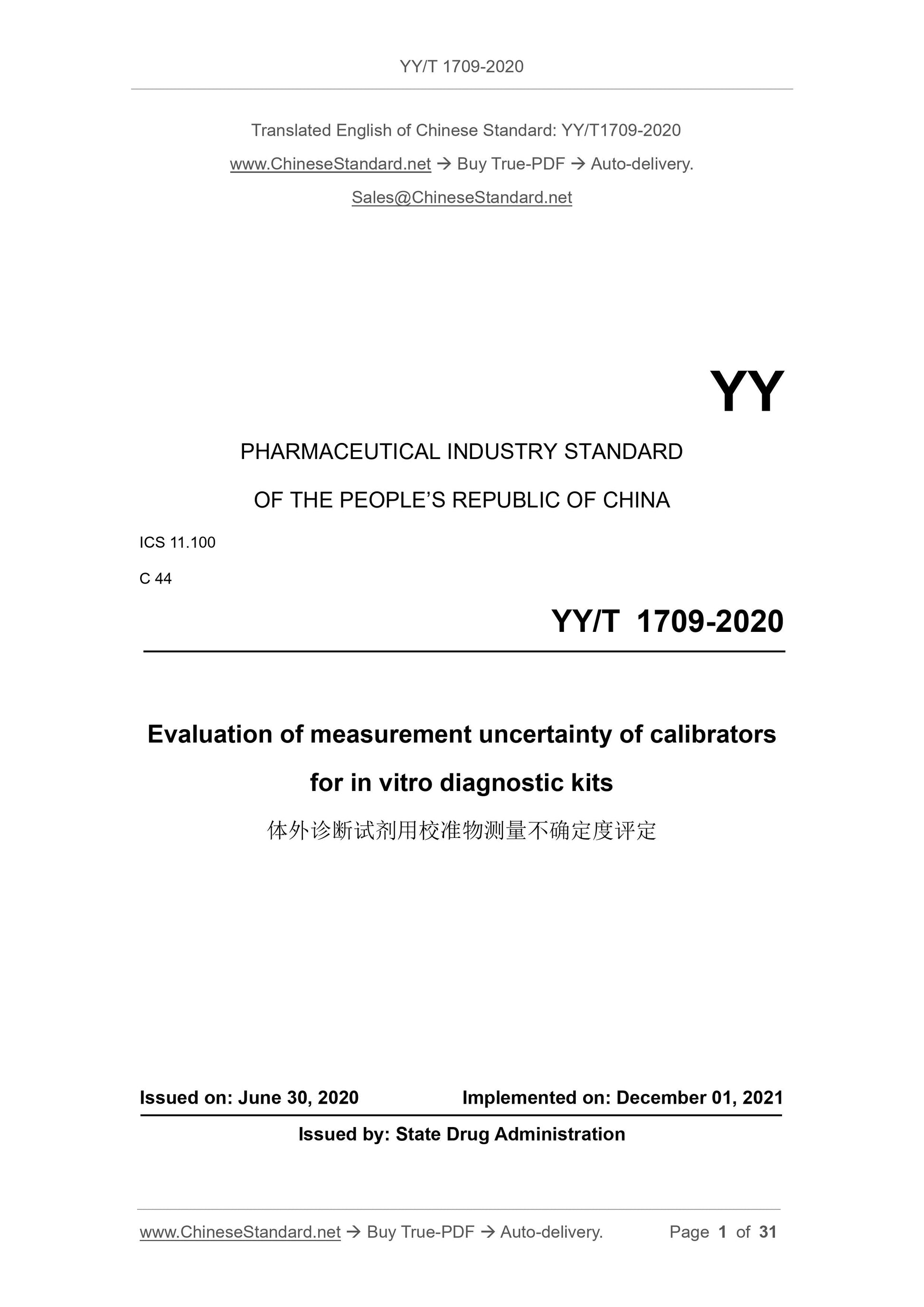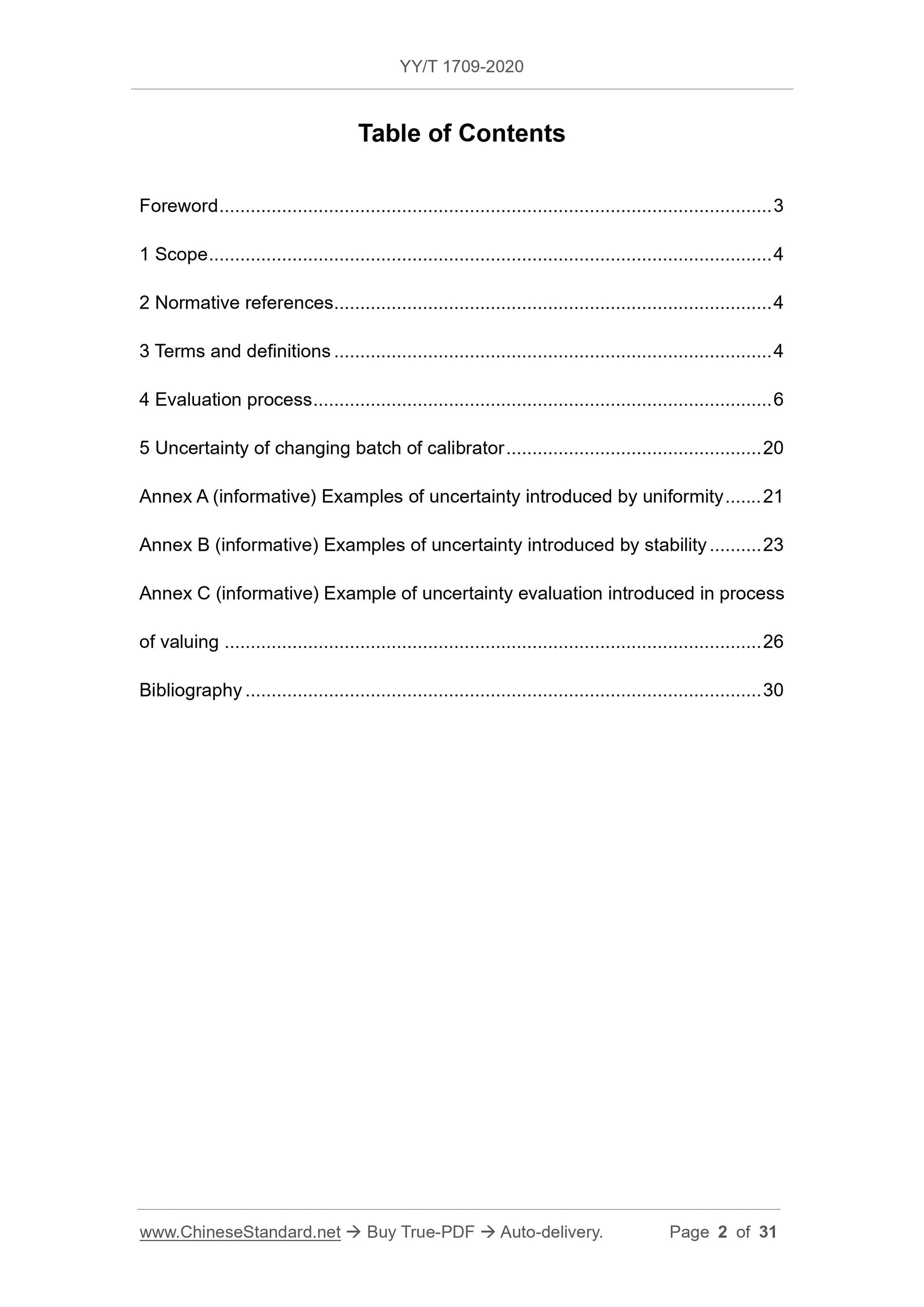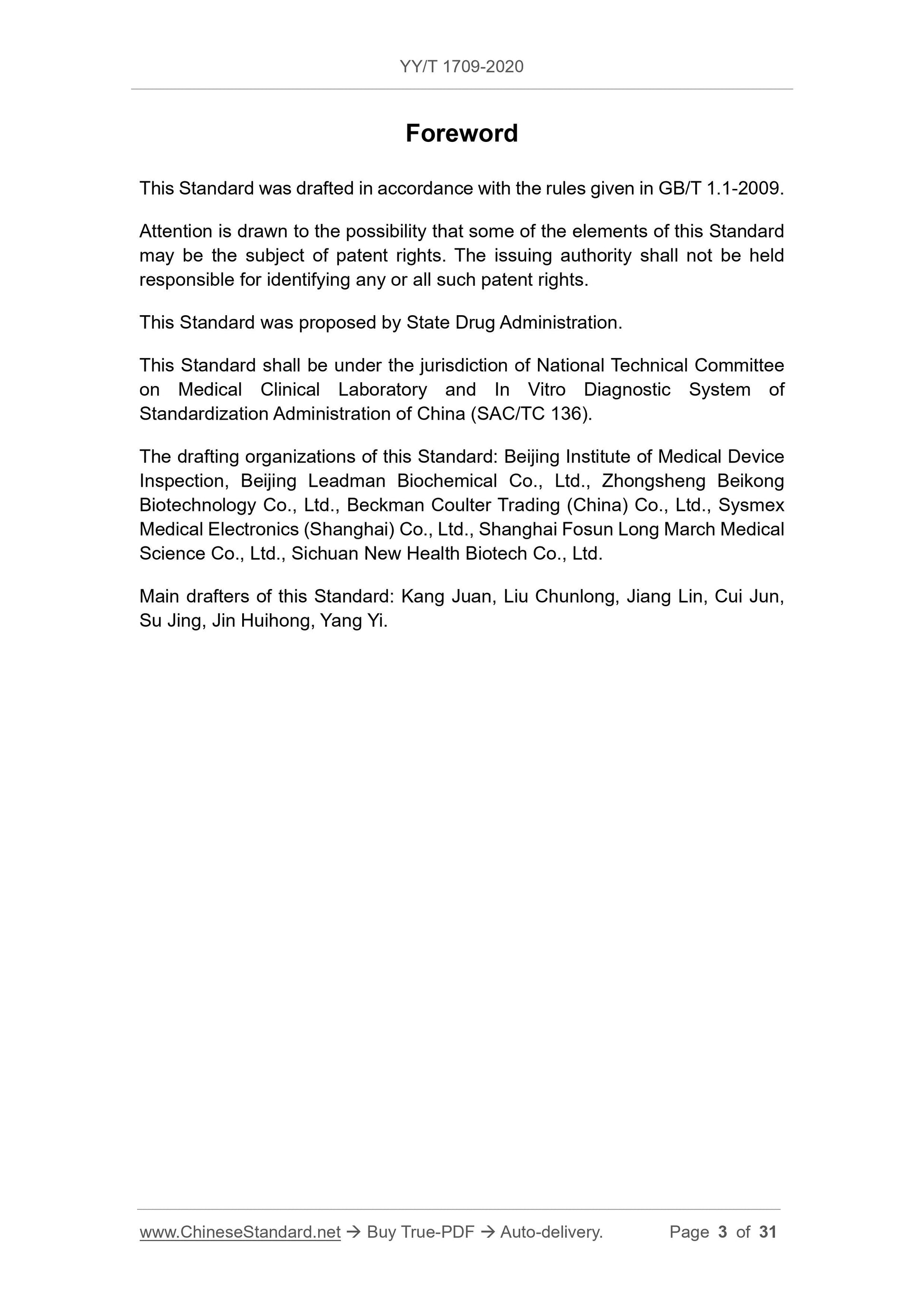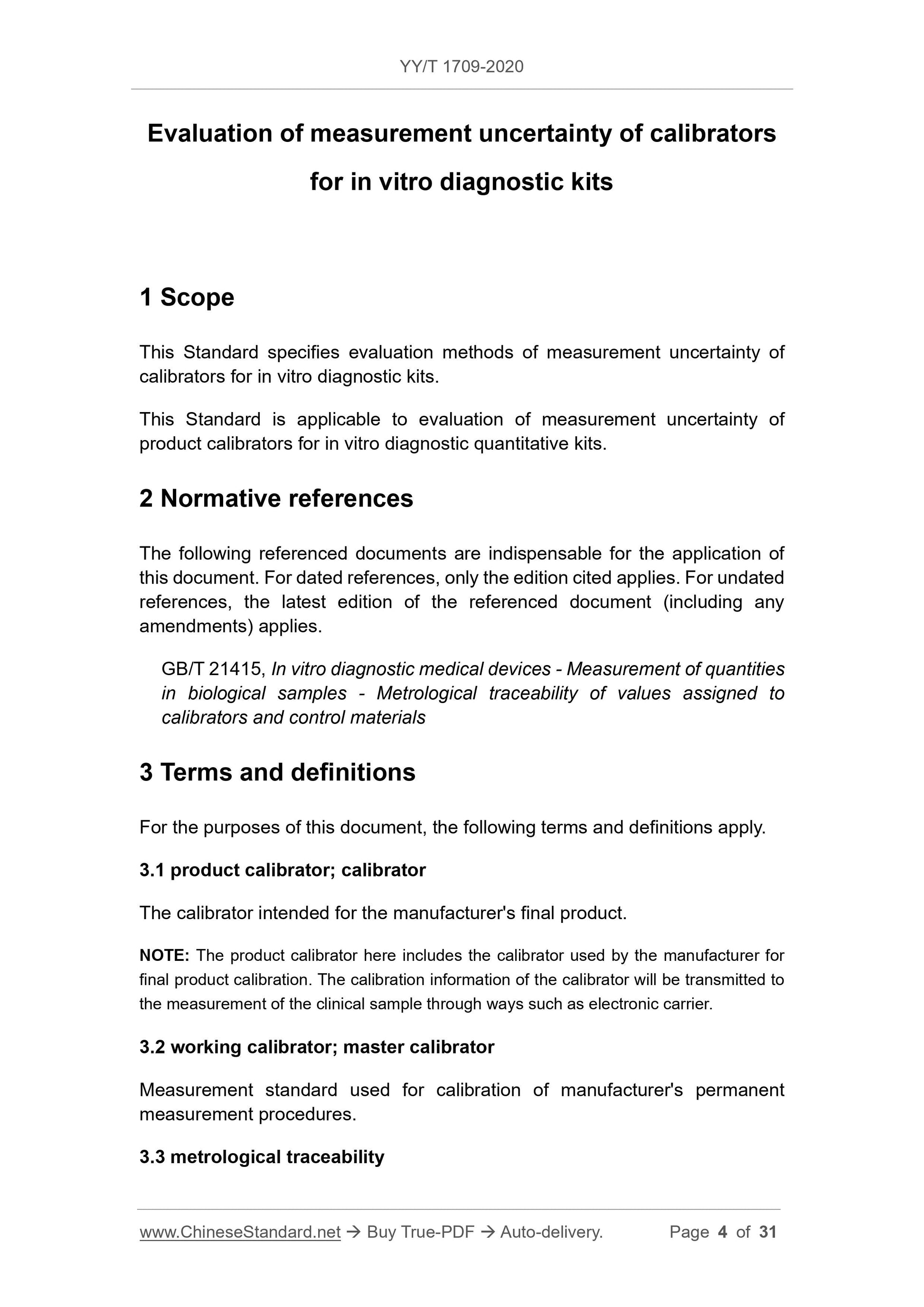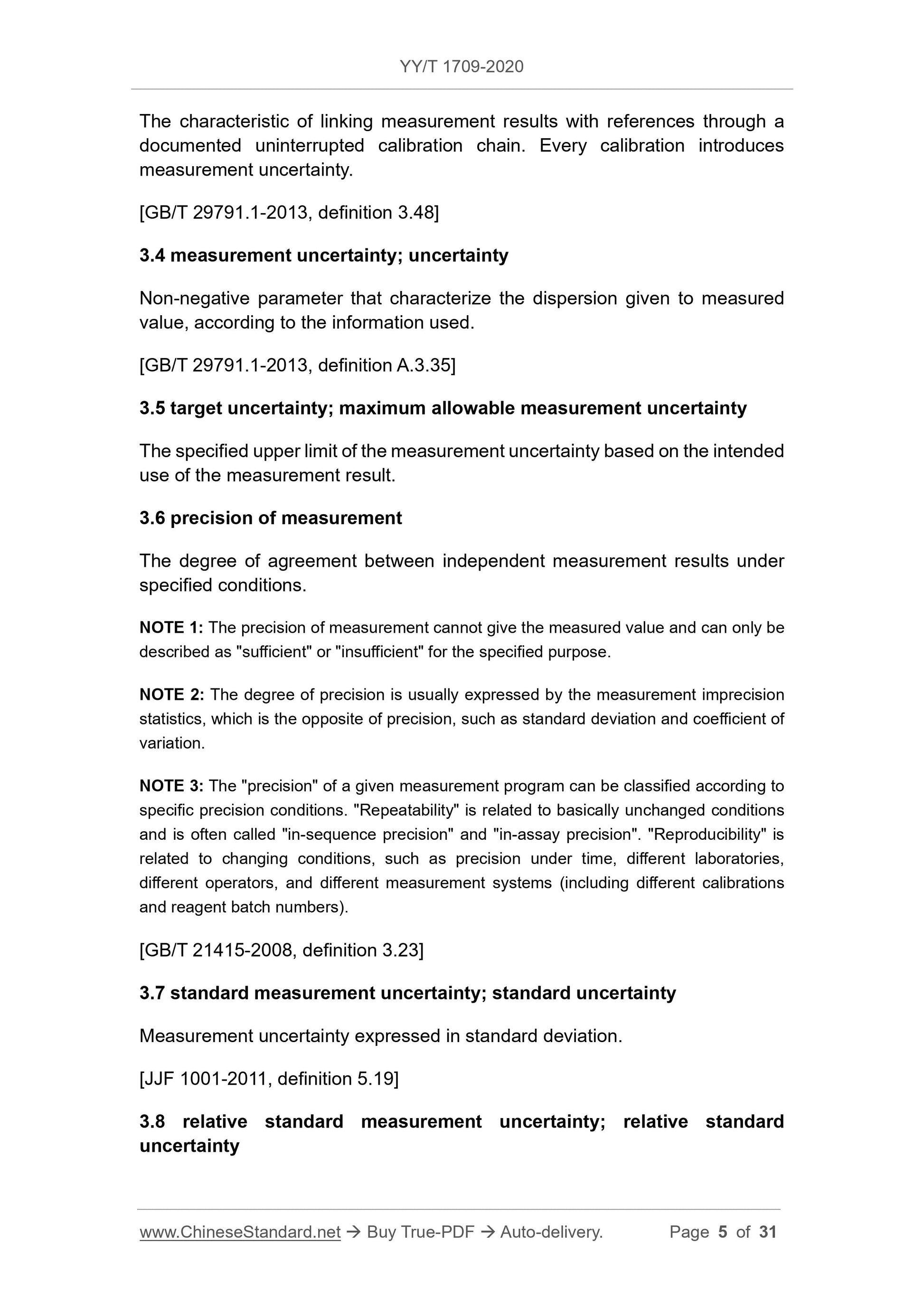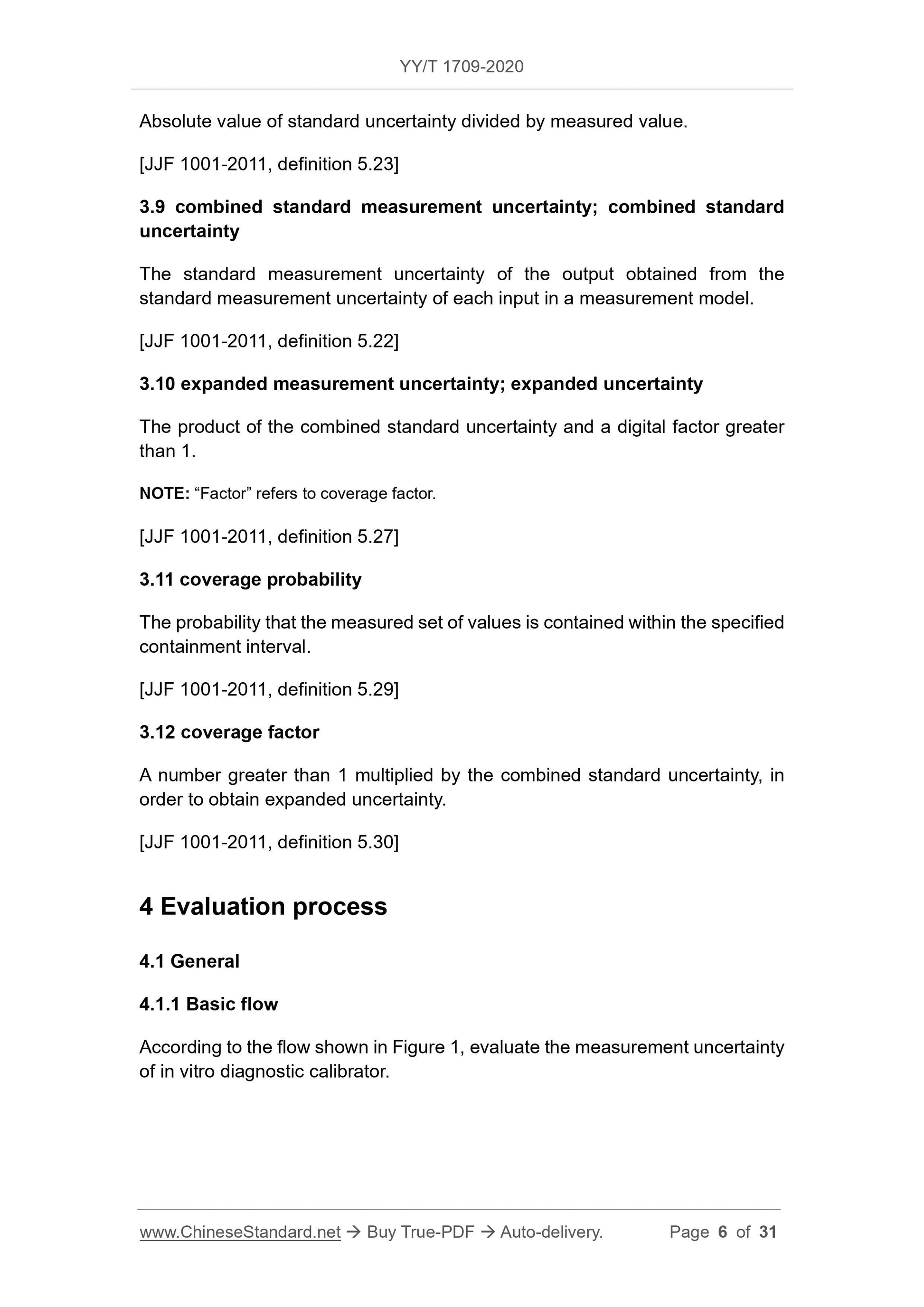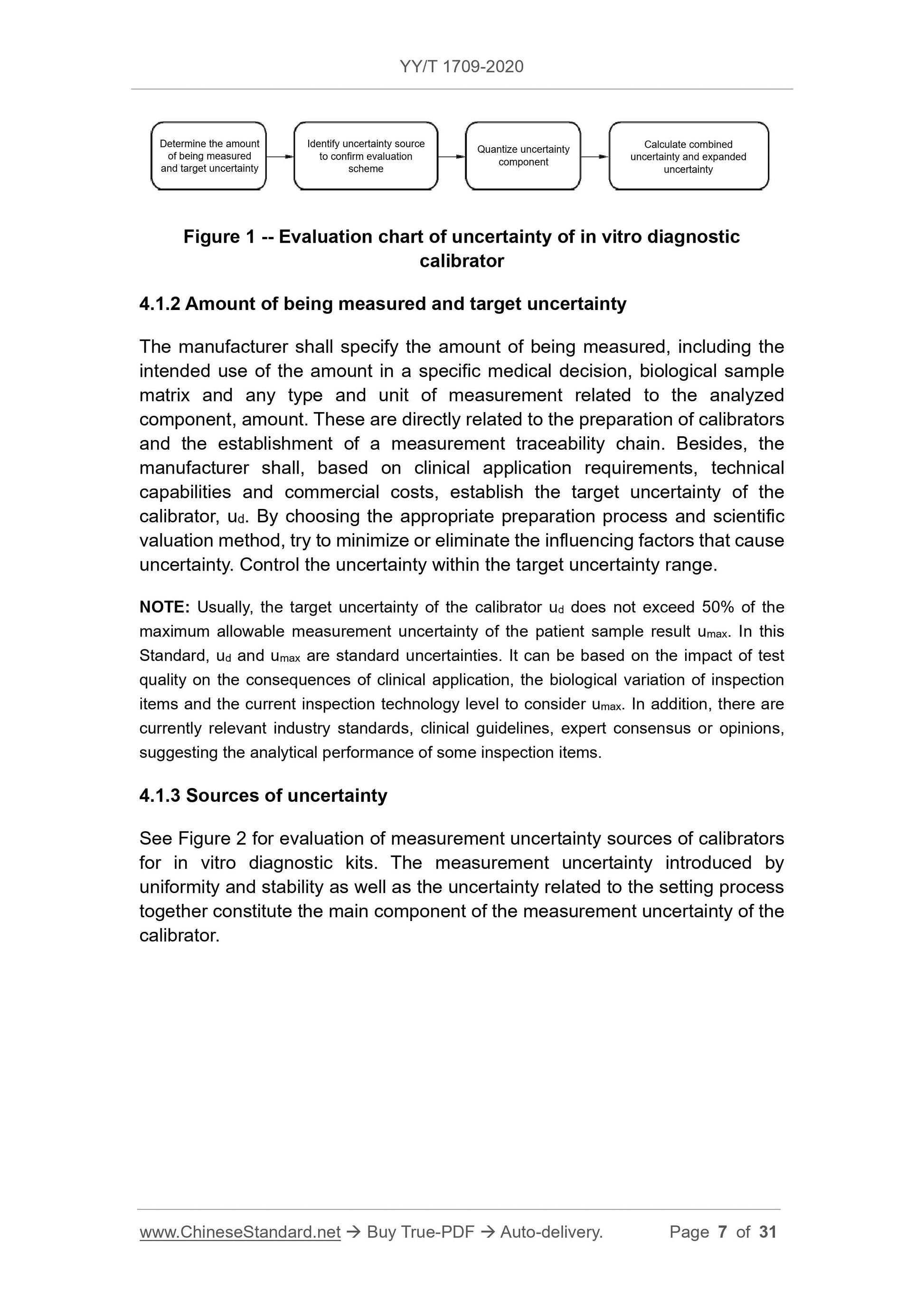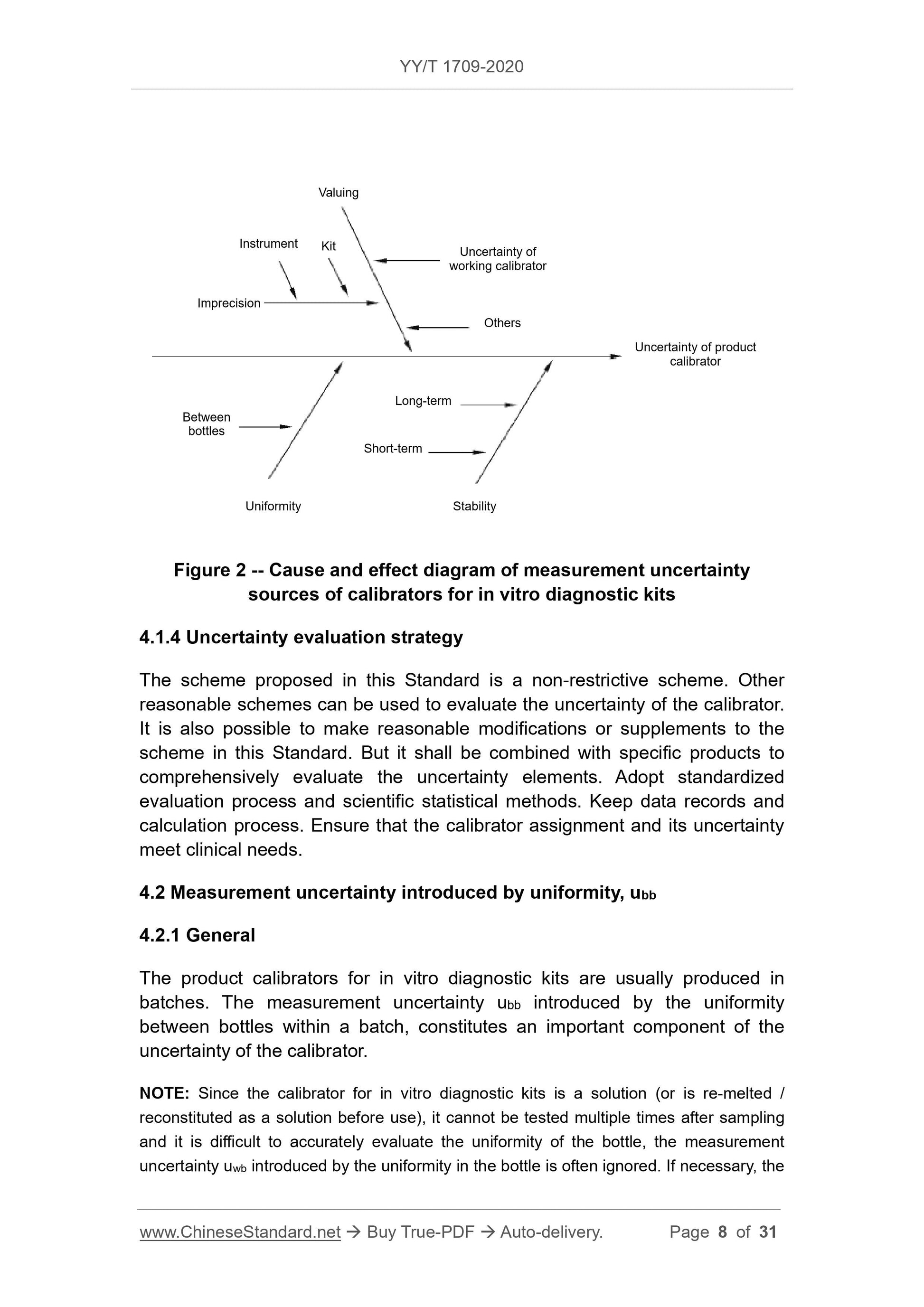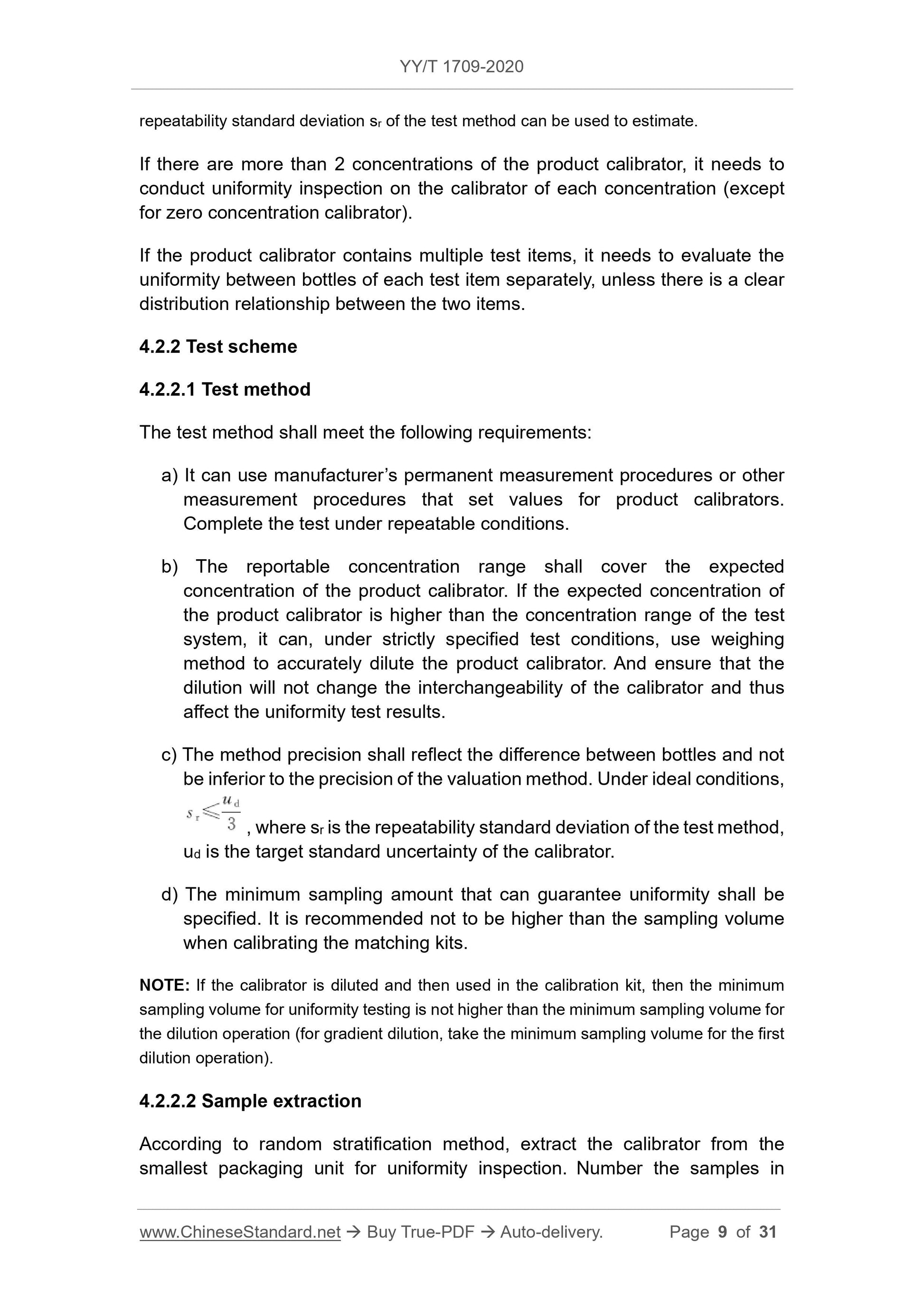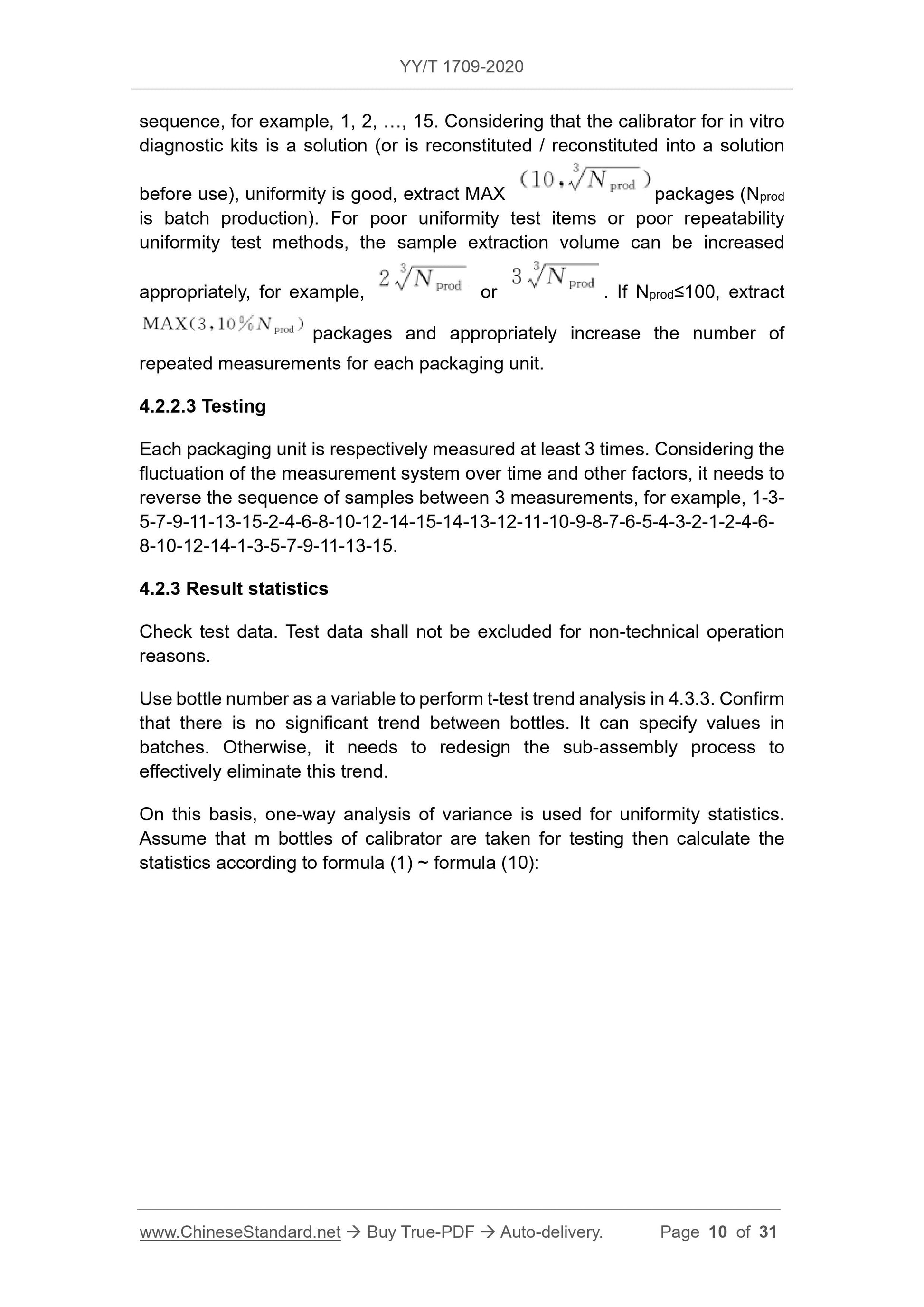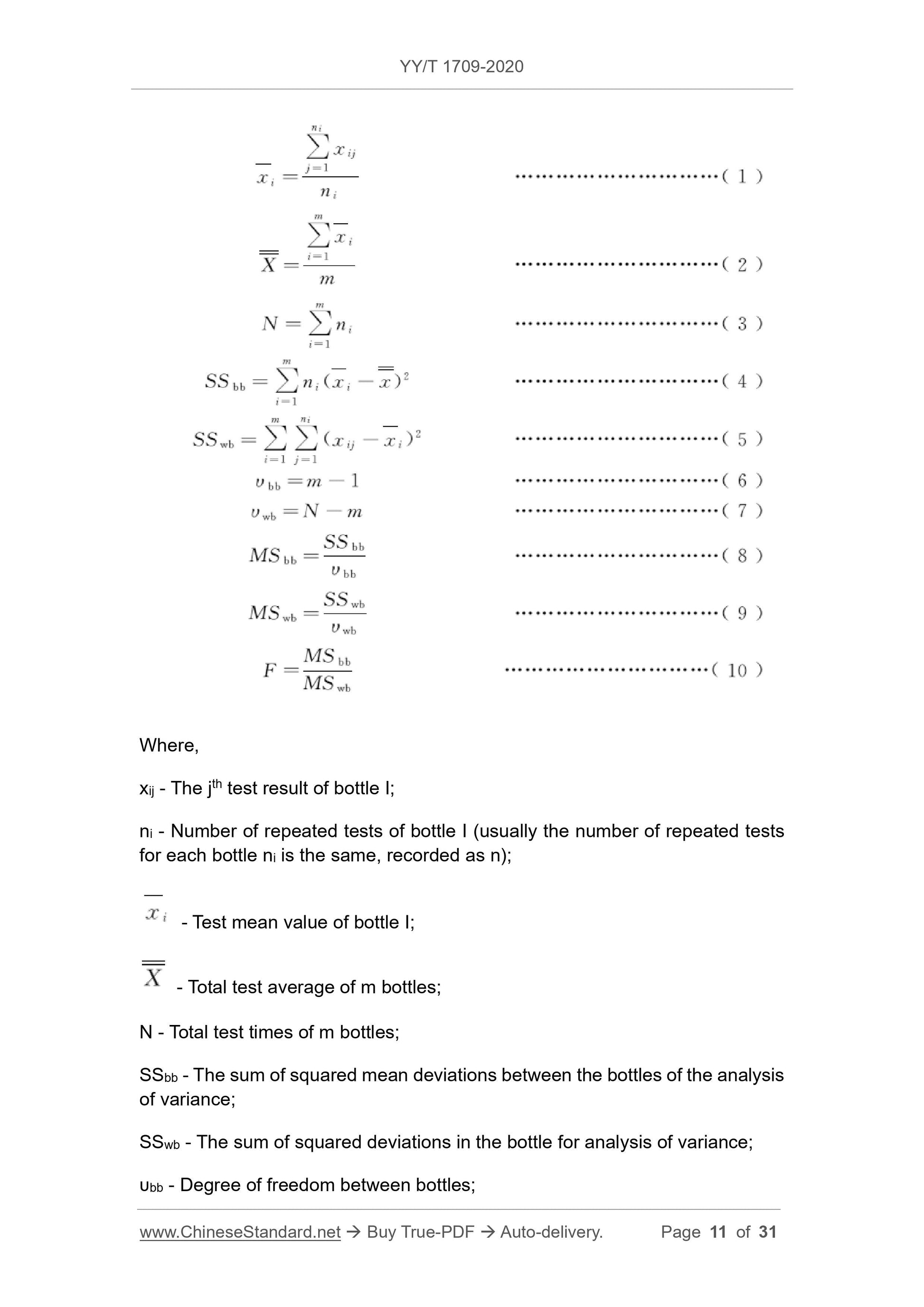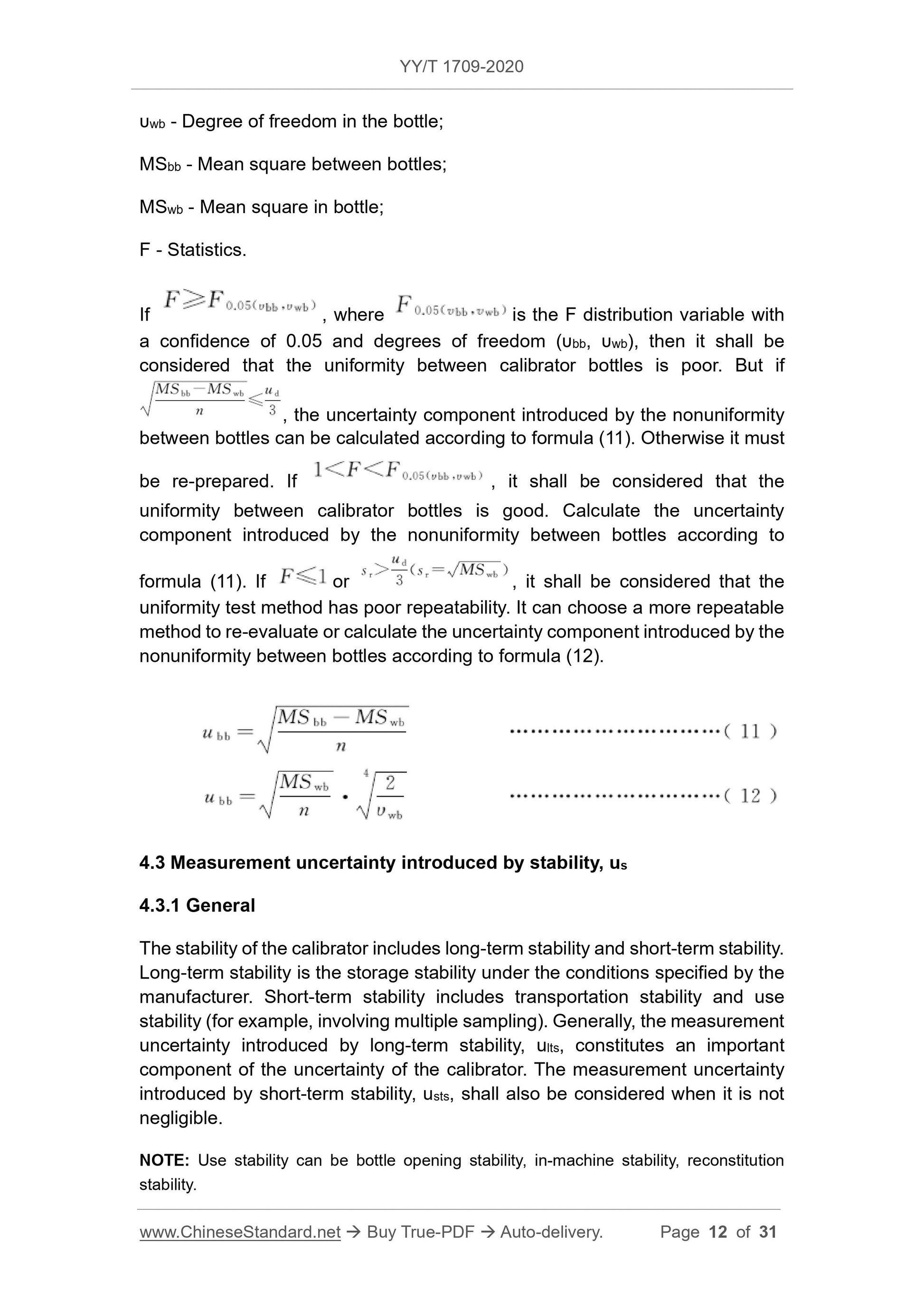1
/
の
12
PayPal, credit cards. Download editable-PDF & invoice in 1 second!
YY/T 1709-2020 English PDF (YYT1709-2020)
YY/T 1709-2020 English PDF (YYT1709-2020)
通常価格
$325.00 USD
通常価格
セール価格
$325.00 USD
単価
/
あたり
配送料はチェックアウト時に計算されます。
受取状況を読み込めませんでした
Delivery: 3 seconds. Download true-PDF + Invoice.
Get QUOTATION in 1-minute: Click YY/T 1709-2020
Historical versions: YY/T 1709-2020
Preview True-PDF (Reload/Scroll if blank)
YY/T 1709-2020: Evaluation of measurement uncertainty of calibrators for in vitro diagnostic kits
YY/T 1709-2020
YY
PHARMACEUTICAL INDUSTRY STANDARD
OF THE PEOPLE’S REPUBLIC OF CHINA
ICS 11.100
C 44
Evaluation of measurement uncertainty of calibrators
for in vitro diagnostic kits
ISSUED ON: JUNE 30, 2020
IMPLEMENTED ON: DECEMBER 01, 2021
Issued by: State Drug Administration
Table of Contents
Foreword ... 3
1 Scope ... 4
2 Normative references ... 4
3 Terms and definitions ... 4
4 Evaluation process ... 6
5 Uncertainty of changing batch of calibrator ... 20
Annex A (informative) Examples of uncertainty introduced by uniformity ... 21
Annex B (informative) Examples of uncertainty introduced by stability ... 23
Annex C (informative) Example of uncertainty evaluation introduced in process
of valuing ... 26
Bibliography ... 30
Evaluation of measurement uncertainty of calibrators
for in vitro diagnostic kits
1 Scope
This Standard specifies evaluation methods of measurement uncertainty of
calibrators for in vitro diagnostic kits.
This Standard is applicable to evaluation of measurement uncertainty of
product calibrators for in vitro diagnostic quantitative kits.
2 Normative references
The following referenced documents are indispensable for the application of
this document. For dated references, only the edition cited applies. For undated
references, the latest edition of the referenced document (including any
amendments) applies.
GB/T 21415, In vitro diagnostic medical devices - Measurement of quantities
in biological samples - Metrological traceability of values assigned to
calibrators and control materials
3 Terms and definitions
For the purposes of this document, the following terms and definitions apply.
3.1 product calibrator; calibrator
The calibrator intended for the manufacturer's final product.
NOTE: The product calibrator here includes the calibrator used by the manufacturer for
final product calibration. The calibration information of the calibrator will be transmitted to
the measurement of the clinical sample through ways such as electronic carrier.
3.2 working calibrator; master calibrator
Measurement standard used for calibration of manufacturer's permanent
measurement procedures.
3.3 metrological traceability
Absolute value of standard uncertainty divided by measured value.
[JJF 1001-2011, definition 5.23]
3.9 combined standard measurement uncertainty; combined standard
uncertainty
The standard measurement uncertainty of the output obtained from the
standard measurement uncertainty of each input in a measurement model.
[JJF 1001-2011, definition 5.22]
3.10 expanded measurement uncertainty; expanded uncertainty
The product of the combined standard uncertainty and a digital factor greater
than 1.
NOTE: “Factor” refers to coverage factor.
[JJF 1001-2011, definition 5.27]
3.11 coverage probability
The probability that the measured set of values is contained within the specified
containment interval.
[JJF 1001-2011, definition 5.29]
3.12 coverage factor
A number greater than 1 multiplied by the combined standard uncertainty, in
order to obtain expanded uncertainty.
[JJF 1001-2011, definition 5.30]
4 Evaluation process
4.1 General
4.1.1 Basic flow
According to the flow shown in Figure 1, evaluate the measurement uncertainty
of in vitro diagnostic calibrator.
repeatability standard deviation sr of the test method can be used to estimate.
If there are more than 2 concentrations of the product calibrator, it needs to
conduct uniformity inspection on the calibrator of each concentration (except
for zero concentration calibrator).
If the product calibrator contains multiple test items, it needs to evaluate the
uniformity between bottles of each test item separately, unless there is a clear
distribution relationship between the two items.
4.2.2 Test scheme
4.2.2.1 Test method
The test method shall meet the following requirements:
a) It can use manufacturer’s permanent measurement procedures or other
measurement procedures that set values for product calibrators.
Complete the test under repeatable conditions.
b) The reportable concentration range shall cover the expected
concentration of the product calibrator. If the expected concentration of
the product calibrator is higher than the concentration range of the test
system, it can, under strictly specified test conditions, use weighing
method to accurately dilute the product calibrator. And ensure that the
dilution will not change the interchangeability of the calibrator and thus
affect the uniformity test results.
c) The method precision shall reflect the difference between bottles and not
be inferior to the precision of the valuation method. Under ideal conditions,
, where sr is the repeatability standard deviation of the test method,
ud is the target standard uncertainty of the calibrator.
d) The minimum sampling amount that can guarantee uniformity shall be
specified. It is recommended not to be higher than the sampling volume
when calibrating the matching kits.
NOTE: If the calibrator is diluted and then used in the calibration kit, then the minimum
sampling volume for uniformity testing is not higher than the minimum sampling volume for
the dilution operation (for gradient dilution, take the minimum sampling volume for the first
dilution operation).
4.2.2.2 Sample extraction
According to random stratification method, extract the calibrator from the
smallest packaging unit for uniformity inspection. Number the samples in
If there are more than 2 concentrations of the product calibrator, it needs to
inspect the stability of each concentration of calibrator (except zero
concentration calibrator).
If the product calibrator contains multiple test items, it needs to evaluate the
stability of each test item separately, unless there is a clear distribution
relationship between the two items.
4.3.2 Test scheme
Stability test can choose "classic" scheme or "synchronous" scheme design.
The classic scheme is to put the samples prepared at the same time under the
expected storage conditions. Take some samples for measurement over time.
It is real-time tracking test of sample stability under reproducibility conditions.
The synchronous scheme takes samples in time-sharing and place them under
certain reference conditions. It is considered that the influence of instability is
not considered under these conditions. Take them out together after the
expected stabilization time. Conduct simultaneous measurement under the
repeatability conditions. The specific choice depends on the precision of the
method and the stability of the sample. Accelerated stability studies or
experience gained from similar in vitro diagnostic kits can only be considered
for estimating the initial expiration date. It cannot substitute the real-time
stability test.
The expected stable timeliness of the calibrator can be preliminarily determined
by referring to the experience of literature and other materials in combination
with the use of requirements. According to the principle of dense first then
sparse, within at least 5 time-intervals of expected stable aging, randomly select
at least 2 calibrators of the smallest packaging unit for stability test. Perform 3
measurements for each packaging unit. The test system used for stability
inspection can choose the same test system as the uniformity inspection. The
precision is not lower than the fixed value system, with ...
Get QUOTATION in 1-minute: Click YY/T 1709-2020
Historical versions: YY/T 1709-2020
Preview True-PDF (Reload/Scroll if blank)
YY/T 1709-2020: Evaluation of measurement uncertainty of calibrators for in vitro diagnostic kits
YY/T 1709-2020
YY
PHARMACEUTICAL INDUSTRY STANDARD
OF THE PEOPLE’S REPUBLIC OF CHINA
ICS 11.100
C 44
Evaluation of measurement uncertainty of calibrators
for in vitro diagnostic kits
ISSUED ON: JUNE 30, 2020
IMPLEMENTED ON: DECEMBER 01, 2021
Issued by: State Drug Administration
Table of Contents
Foreword ... 3
1 Scope ... 4
2 Normative references ... 4
3 Terms and definitions ... 4
4 Evaluation process ... 6
5 Uncertainty of changing batch of calibrator ... 20
Annex A (informative) Examples of uncertainty introduced by uniformity ... 21
Annex B (informative) Examples of uncertainty introduced by stability ... 23
Annex C (informative) Example of uncertainty evaluation introduced in process
of valuing ... 26
Bibliography ... 30
Evaluation of measurement uncertainty of calibrators
for in vitro diagnostic kits
1 Scope
This Standard specifies evaluation methods of measurement uncertainty of
calibrators for in vitro diagnostic kits.
This Standard is applicable to evaluation of measurement uncertainty of
product calibrators for in vitro diagnostic quantitative kits.
2 Normative references
The following referenced documents are indispensable for the application of
this document. For dated references, only the edition cited applies. For undated
references, the latest edition of the referenced document (including any
amendments) applies.
GB/T 21415, In vitro diagnostic medical devices - Measurement of quantities
in biological samples - Metrological traceability of values assigned to
calibrators and control materials
3 Terms and definitions
For the purposes of this document, the following terms and definitions apply.
3.1 product calibrator; calibrator
The calibrator intended for the manufacturer's final product.
NOTE: The product calibrator here includes the calibrator used by the manufacturer for
final product calibration. The calibration information of the calibrator will be transmitted to
the measurement of the clinical sample through ways such as electronic carrier.
3.2 working calibrator; master calibrator
Measurement standard used for calibration of manufacturer's permanent
measurement procedures.
3.3 metrological traceability
Absolute value of standard uncertainty divided by measured value.
[JJF 1001-2011, definition 5.23]
3.9 combined standard measurement uncertainty; combined standard
uncertainty
The standard measurement uncertainty of the output obtained from the
standard measurement uncertainty of each input in a measurement model.
[JJF 1001-2011, definition 5.22]
3.10 expanded measurement uncertainty; expanded uncertainty
The product of the combined standard uncertainty and a digital factor greater
than 1.
NOTE: “Factor” refers to coverage factor.
[JJF 1001-2011, definition 5.27]
3.11 coverage probability
The probability that the measured set of values is contained within the specified
containment interval.
[JJF 1001-2011, definition 5.29]
3.12 coverage factor
A number greater than 1 multiplied by the combined standard uncertainty, in
order to obtain expanded uncertainty.
[JJF 1001-2011, definition 5.30]
4 Evaluation process
4.1 General
4.1.1 Basic flow
According to the flow shown in Figure 1, evaluate the measurement uncertainty
of in vitro diagnostic calibrator.
repeatability standard deviation sr of the test method can be used to estimate.
If there are more than 2 concentrations of the product calibrator, it needs to
conduct uniformity inspection on the calibrator of each concentration (except
for zero concentration calibrator).
If the product calibrator contains multiple test items, it needs to evaluate the
uniformity between bottles of each test item separately, unless there is a clear
distribution relationship between the two items.
4.2.2 Test scheme
4.2.2.1 Test method
The test method shall meet the following requirements:
a) It can use manufacturer’s permanent measurement procedures or other
measurement procedures that set values for product calibrators.
Complete the test under repeatable conditions.
b) The reportable concentration range shall cover the expected
concentration of the product calibrator. If the expected concentration of
the product calibrator is higher than the concentration range of the test
system, it can, under strictly specified test conditions, use weighing
method to accurately dilute the product calibrator. And ensure that the
dilution will not change the interchangeability of the calibrator and thus
affect the uniformity test results.
c) The method precision shall reflect the difference between bottles and not
be inferior to the precision of the valuation method. Under ideal conditions,
, where sr is the repeatability standard deviation of the test method,
ud is the target standard uncertainty of the calibrator.
d) The minimum sampling amount that can guarantee uniformity shall be
specified. It is recommended not to be higher than the sampling volume
when calibrating the matching kits.
NOTE: If the calibrator is diluted and then used in the calibration kit, then the minimum
sampling volume for uniformity testing is not higher than the minimum sampling volume for
the dilution operation (for gradient dilution, take the minimum sampling volume for the first
dilution operation).
4.2.2.2 Sample extraction
According to random stratification method, extract the calibrator from the
smallest packaging unit for uniformity inspection. Number the samples in
If there are more than 2 concentrations of the product calibrator, it needs to
inspect the stability of each concentration of calibrator (except zero
concentration calibrator).
If the product calibrator contains multiple test items, it needs to evaluate the
stability of each test item separately, unless there is a clear distribution
relationship between the two items.
4.3.2 Test scheme
Stability test can choose "classic" scheme or "synchronous" scheme design.
The classic scheme is to put the samples prepared at the same time under the
expected storage conditions. Take some samples for measurement over time.
It is real-time tracking test of sample stability under reproducibility conditions.
The synchronous scheme takes samples in time-sharing and place them under
certain reference conditions. It is considered that the influence of instability is
not considered under these conditions. Take them out together after the
expected stabilization time. Conduct simultaneous measurement under the
repeatability conditions. The specific choice depends on the precision of the
method and the stability of the sample. Accelerated stability studies or
experience gained from similar in vitro diagnostic kits can only be considered
for estimating the initial expiration date. It cannot substitute the real-time
stability test.
The expected stable timeliness of the calibrator can be preliminarily determined
by referring to the experience of literature and other materials in combination
with the use of requirements. According to the principle of dense first then
sparse, within at least 5 time-intervals of expected stable aging, randomly select
at least 2 calibrators of the smallest packaging unit for stability test. Perform 3
measurements for each packaging unit. The test system used for stability
inspection can choose the same test system as the uniformity inspection. The
precision is not lower than the fixed value system, with ...
Share
